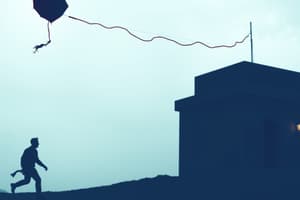Podcast
Questions and Answers
What narrative viewpoint does Khaled Hosseini use in 'The Kite Runner'?
What narrative viewpoint does Khaled Hosseini use in 'The Kite Runner'?
First-person narrator (Amir)
How does the author provide insight into the narrator's thoughts, feelings, and motivations?
How does the author provide insight into the narrator's thoughts, feelings, and motivations?
Through the first-person narrative
What type of structure does 'The Kite Runner' have?
What type of structure does 'The Kite Runner' have?
Nonlinear structure
What literary device connects the chapters in the novel?
What literary device connects the chapters in the novel?
Name one of the key themes explored in 'The Kite Runner.'
Name one of the key themes explored in 'The Kite Runner.'
What do kites symbolize in 'The Kite Runner'?
What do kites symbolize in 'The Kite Runner'?
Who collects jars of urine in the novel, and what do they symbolize?
Who collects jars of urine in the novel, and what do they symbolize?
Explain the relationship between Amir and Hassan in 'The Kite Runner'.
Explain the relationship between Amir and Hassan in 'The Kite Runner'.
Who is torn between tradition and modernity in the novel?
Who is torn between tradition and modernity in the novel?
What societal dynamics do the main characters in 'The Kite Runner' illustrate?
What societal dynamics do the main characters in 'The Kite Runner' illustrate?
Flashcards are hidden until you start studying
Study Notes
The Kite Runner
"The Kite Runner," a novel by Khaled Hosseini, is a poignant tale of friendship, betrayal, and redemption set against the backdrop of the Soviet invasion of Afghanistan and the subsequent civil war. This article provides a comprehensive analysis of the narrative, structure, themes, symbols, and characters in Hosseini's acclaimed work.
Narrative Viewpoint Analysis
Hosseini uses the first-person narrator Amir, who recalls events from his childhood to present day. By doing so, readers gain insight into the narrator's thoughts, feelings, and motivations throughout the story. Additionally, the author uses multiple focal points within this narrative, allowing readers to see different perspectives on key events. For example, the perspective of Hassan, a Hazara servant and Amir's closest friend, is explored towards the end of the book.
Structure Examination
The novel has a nonlinear structure, beginning with Amir remembering a pivotal moment from his childhood and concluding with his return to Afghanistan after Shah Rukh's death. Amir's tragic past unfolds through flashbacks, providing context for his actions and motivations. Furthermore, each chapter begins with a quote from or allusion to the Persian epic poem, "Khosrow and Shirin," which serves as a connecting thread throughout the novel.
Themes Exploration
Some key themes in "The Kite Runner" include identity, guilt, love, loyalty, and redemption. These themes are expressed most prominently through the relationships between various characters, such as Amir and Hassan, Amir and Baba, and Amir and Sohrab. These connections expose the complexities and challenges faced by individuals seeking to navigate their cultural backgrounds and personal desires.
Symbols Interpretation
Symbolism plays a significant role in the novel, with recurring motifs like kites, snowmen, and the game of jacks representing different aspects of the characters and their experiences. For instance, kites symbolize freedom and control, while snowmen represent innocence and vulnerability. The jars of urine collected by Assef serve as a stark reminder of the depravity caused by societal unrest and oppression.
Main Characters Study
Three central figures in the novel are Amir, Hassan, and Baba:
- Amir: A young boy who grows up to become a successful writer, grappling with feelings of guilt and redemption related to his relationship with Hassan.
- Hassan: An innocent yet cunning Hazara boy who forms a deep bond with Amir, despite societal prejudices and class differences.
- Baba: Amir's father, a man torn between tradition and modernity, who attempts to instill strong values in his son while dealing with his own romantic secrets.
These characters illustrate the various facets of Afghan society during a time of turmoil and change. Their interconnected lives reveal the impact of cultural dynamics and political circumstances on personal relationships.
In conclusion, "The Kite Runner" offers a multifaceted portrayal of life in Afghanistan before and after the Soviet invasion, exploring the complexities of individual identity and societal norms through its well-structured narrative, vivid symbolism, and compelling characters.
Studying That Suits You
Use AI to generate personalized quizzes and flashcards to suit your learning preferences.




